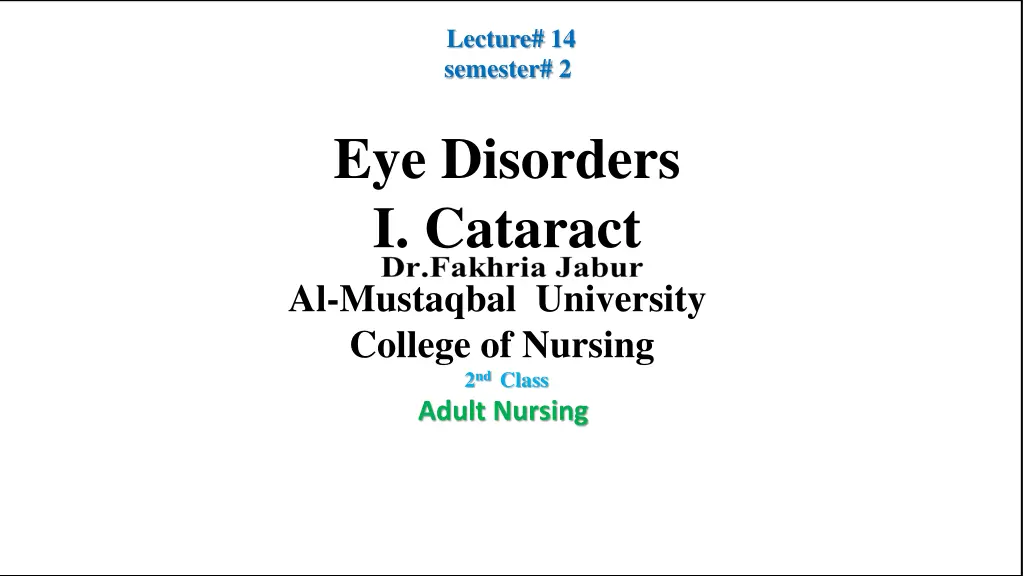
Understanding Cataracts: Causes, Risk Factors, and Symptoms
Learn about cataracts, a common eye disorder characterized by lens cloudiness. Explore the pathophysiology, risk factors, and associated ocular conditions, such as infection and myopia. Discover the clinical manifestations, including blurred vision and diplopia. Understand the toxic, nutritional, and physical factors that contribute to cataract development.
Download Presentation

Please find below an Image/Link to download the presentation.
The content on the website is provided AS IS for your information and personal use only. It may not be sold, licensed, or shared on other websites without obtaining consent from the author. If you encounter any issues during the download, it is possible that the publisher has removed the file from their server.
You are allowed to download the files provided on this website for personal or commercial use, subject to the condition that they are used lawfully. All files are the property of their respective owners.
The content on the website is provided AS IS for your information and personal use only. It may not be sold, licensed, or shared on other websites without obtaining consent from the author.
E N D
Presentation Transcript
Lecture# 14 semester# 2 Eye Disorders I. Cataract Al-Mustaqbal University College of Nursing 2nd Class Adult Nursing
Cataract A cataract :is a lens opacity or cloudiness. A cataract is a cloudy or opaque lens. On visual inspection, the lens appears gray or milky. Cataracts are a leading cause of blindness in the world. The three most common types are traumatic, congenital, or senile cataract.
Pathophysiology Cataract can develop in one or both eyes at any age. Three common type of cataract are define by their location in the lens: 1. Nuclear 2. Cortical 3. Posterior subcapsular
RISK FACTORS Aging: Accumulation of a yellow-brown pigment due to the breakdown of lens protein Decreased oxygen uptake Decrease in levels of vitamin C, protein, and glutathione (an antioxidant) Increase in sodium and calcium Loss of lens transparency
Associated Ocular Conditions Infection (e.g., herpes zoster, uveitis) Myopia Retinal detachment and retinal surgery Retinitis pigmentosa.
Toxic Factors Ionizing radiation Aspirin use Corticosteroids Alkaline chemical eye burns, poisoning Cigarette smoking Calcium, copper, iron, gold, silver, and mercury
CONT. Nutritional Factors: Obesity Poor nutrition Reduced levels of antioxidants Systemic Diseases and Syndromes: Diabetes Disorders related to lipid metabolism Down syndrome Musculoskeletal disorders Renal disorders
CONT. Physical factors: Dehydration Blunt trauma Electrical shock Perforation of the lens with sharp object or foreign body Ultraviolent radiation in sunlight and x-ray
Clinical Manifestation Painless Blurred vision Diplopia Reduce visual acuity Astigmatism: refractive error due to an irregularity in the curvature of the cornea.
Medical Management Treatment cures cataract or prevents age-related cataract. Medications Eye drops eye glasses In the early stage of cataract development the vision may improve by: Glasses Contact lenses
Assessment and Diagnostic Methods 1- The Snellen visual acuity test. 2- Ophthalmoscope 3- Slit lamp examination.
Surgical Management Intracapsular cataract Extraction Extracapsular cataract Extraction Phacomulisification Lens Replacement
Nursing management Providing preoperative care: Withhold any anticoagulation(e.g. aspirin, warfarin) to reduce the risk of hemorrhage. Dilating drops are administer every 10 minutes for 4 doses at least one hour before surgery.
CONT. Providing postoperative care: The patient receive verbal and written instruction about how protect the eye. Administer medication. Recognizes the signs of complications and obtain emergency care. Instruct the patient to take a mild analgesia agent, as needed. Anti-inflammatory and corticosteroid eye drops or ointment.
Promoting home and community-based care Teaching patient self care: Eye patch for 24 hrs after surgery. Followed by eye glasses worn during the day. Sunglasses should be worn. A clean , damp wash cloth may be used to remove eye discharge. Continuity care Eye patch remove after the first follow up appointment . Vision is stabilized when the eye healed, usually within 6-12 weeks.
1-Healthy human ear can hear frequencies in the range from a.20Hz to 20,000 Hz b.20Hzto 25,000Hz c.30Hz to 30,000Hz d.25Hz to 30Hz
2- The instrument to examine the ear is a- Ophthalmoscope b- Otoscope c- Thermometer d- Stethoscope
3- sinuses. Chronic sinusitis is diagnosed if symptoms are present for Sinusitis is inflammation of the mucosa of one or more a- More than one month b- More than two month c- More than two week d- Recurrent every years
4- swelling and promote drainage After the tonsillectomy, put the patient in-------- to reduce a- Supine position b- Prone position c- sitting position d- semi-Fowler s position
5- the nose that mean: nurse examine the patient show the bleeding from a- Rhinorrhea b- Epistaxis c- Anosmia d- dysphagia






















